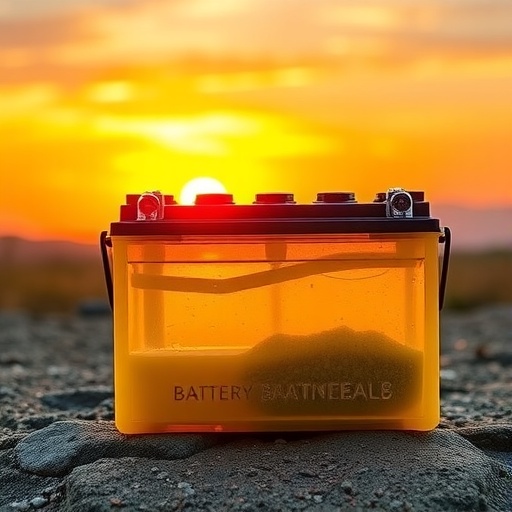In an inspiring leap towards sustainability and innovation within the chemical industry, a remarkable study has unveiled a novel application of recycled lithium-ion battery cathodes. Conducted by researchers Lima, Garcia, Taroco, and their team, this breakthrough transforms waste materials into valuable resources. The project is characterized by its focus on the catalytic conversion of sunset yellow, a synthetic dye, into functional aromatics. With increasing environmental concerns surrounding waste management and resource depletion, this research provides a timely solution that combines ecological responsibility with technological advancement.
The world currently faces a considerable dilemma in dealing with the waste produced by expired lithium-ion batteries. With increasing reliance on electronic devices, the improper disposal of these batteries has detrimental impacts on our environment. However, Lima and her colleagues bring hope through their innovative approach, demonstrating that such waste can be revitalized into essential catalysts for industrial applications. The study is not just a step forward for recycling but a significant stride towards chemical sustainability.
Sunset yellow, a commonly used food dye, has applications ranging from food production to pharmaceuticals. However, conventional methods for its degradation have often led to environmental pollution, posing a threat to ecosystems and human health. The team’s research has successfully identified a pathway where recycled battery components serve as catalysts to convert sunset yellow into functional aromatics, showcasing a green chemistry approach that minimizes adverse ecological impacts.
The process begins with the meticulous extraction of valuable materials from spent lithium-ion batteries. The cathode, typically rich in transition metals like cobalt or nickel, becomes a pivotal component in catalyzing the degradation of sunset yellow. By leveraging the unique properties of these metals, the researchers are able to enhance the efficiency of the conversion process, turning what was once considered waste into a functional element capable of supporting vital industrial processes.
The implications of this research extend far beyond the lab. Functional aromatics produced from the degradation of sunset yellow can serve as precursors in the synthesis of pharmaceuticals, agrochemicals, and various industrial solvents. This transformation not only addresses the waste issue but contributes significantly to the development of sustainable chemical processes. By utilizing a waste material, the study directly aligns with circular economy principles, where the lifecycle of materials is extended and their overall environmental impact is reduced.
Moreover, the catalytic properties of recycled materials demonstrate the potential to redefine how industries perceive waste. This paradigm shift opens doors for other innovations, suggesting that various forms of waste could similarly be converted into valuable materials. As researchers delve deeper into this field, the findings could inspire a wave of new projects aimed at transforming various types of waste into functional industrial catalysts.
The economic ramifications of this research are equally significant. The chemical industry is often scrutinized for its resource consumption and environmental footprint. However, by converting waste into value-added products, companies can potentially reduce costs associated with raw material procurement while simultaneously enhancing their sustainability profiles. The ability to recycle battery materials and repurpose them for catalytic processes presents a lucrative opportunity for businesses aiming to operate responsibly within a competitive market.
This pioneering work has not gone unnoticed in the scientific community. As environmental policies tighten and sustainability becomes a more pressing concern, studies like Lima et al.’s help pave the way for greener alternatives in various sectors. The publication of this research in Ionics marks a crucial acknowledgment of the importance of integrating waste management into mainstream chemical production practices.
Furthermore, the technique showcased in this research could inspire future innovations across multiple domains. Researchers worldwide can build on these findings to explore other waste materials and their potential applications in catalysis. This kind of collaborative exploration can expedite advancements in environmental sustainability, creating a robust network of innovative solutions that tackle pressing global challenges.
As the epoch of sustainability continues to gain traction, the distinction between waste and resource becomes increasingly blurred. This study not only redefines waste but highlights the critical role of recycling in today’s economy. The journey from waste to value encapsulates a broader vision that could reshape industries and elevate our understanding of resource management.
In summarizing the transformational nature of Lima and her team’s work, society is presented with a critical question: how can we further exploit our waste to innovate for the future? This research serves as a compelling response, urging both scientists and industry leaders alike to rethink their approaches to waste, resource management, and production methodologies. The trend towards sustainable practices is not just a choice but a necessity for the well-being of our planet.
As we move towards a more sustainable future, the implications of studies like this will resonate throughout various sectors, influencing policies, shaping industry standards, and igniting new research initiatives. The intersection of chemistry, sustainability, and waste management is indeed where the future lies, and research such as this underscores the importance of fostering innovation in these critical areas.
As we anticipate the official release of this groundbreaking study on November 14, 2025, it becomes imperative to recognize not just its scientific achievements but its broader implications for our global community. This research has the potential to ignite a revolution in recycling practices, catalyzing a series of advancements that could redefine our relationship with waste and the fundamental principles of chemical production. Through the ingenious use of recycled materials, we stand on the brink of a transformative era in which waste is no longer viewed as an obstacle but rather as an opportunity for change.
Subject of Research: Catalytic conversion of sunset yellow using recycled lithium-ion battery cathodes.
Article Title: From waste to value: recycled Li-ion battery cathode catalyzes the transformation of sunset yellow into functional aromatics.
Article References:
Lima, L.T., Garcia, E.M., Taroco, H.A. et al. From waste to value: recycled Li-ion battery cathode catalyzes the transformation of sunset yellow into functional aromatics.
Ionics (2025). https://doi.org/10.1007/s11581-025-06821-0
Image Credits: AI Generated
DOI:
Keywords: recycling, lithium-ion batteries, catalytic conversion, sunset yellow, functional aromatics, sustainability, waste management, green chemistry.




